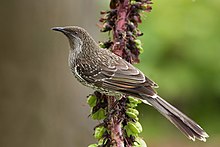The little wattlebird (Anthochaera chrysoptera), also known as the brush wattlebird, is a passerine bird in the honeyeater family Meliphagidae. It is found in coastal and sub-coastal south-eastern Australia.
| Little wattlebird | |
|---|---|
 | |
| Scientific classification | |
| Domain: | Eukaryota |
| Kingdom: | Animalia |
| Phylum: | Chordata |
| Class: | Aves |
| Order: | Passeriformes |
| Family: | Meliphagidae |
| Genus: | Anthochaera |
| Species: | A. chrysoptera |
| Binomial name | |
| Anthochaera chrysoptera (Latham, 1801) | |
Taxonomy
The little wattlebird was formally described by ornithologist John Latham in 1801 under the binomial name Merops chrysoptera.[2] The species is now placed in the genus Anthochaera that was introduced by Nicholas Aylward Vigors and Thomas Horsfield in 1827.[3][4] The generic name Anthochaera derives from the Ancient Greek anthos 'flower, bloom' and khairō 'enjoy'; the specific epithet chrysoptera derives from Ancient Greek khrysos 'gold' and pteron 'wing'.[5]
The International Ornithologists' Union recognise three subspecies:[4]
- A. c. chrysoptera (Latham, 1801) – eastern and southeastern Australia
- A. c. halmaturina (Mathews, 1912) – Kangaroo Island (South Australia)
- A. c. tasmanica (Mathews, 1912) – Tasmania
The western wattlebird (A. lunulata) was at one time considered as the subspecies A. c. lunulata.[6]

Description
The little wattlebird is a medium to large honeyeater, but the smallest wattlebird.[7] The appearance is similar to the yellow wattlebird and the red wattlebird.[8] The little wattlebird lacks the wattles, which characterise other members of the genus. Juveniles are duller with less streaking and have a browner eye.[7]
Calls include a strident cookay-cok, a raucous fetch the gun, a mellow guttural yekkop, yekkop and many squeaky, musical lilting notes. The alarm call is a kwock or shnairt!.[8]
Distribution and habitat
The little wattlebird is found in banksia/eucalypt woodlands, heathlands, tea-tree scrub, sandplain-heaths, lantana thickets, wild tobacco, parks and gardens.[8]
Behaviour

Breeding
Breeding takes place from June to December.[8] The female wattlebird generally constructs the nest,[7] which is a loose, untidy cup of twigs, lined with shredded bark, and placed from 1 to 10 m high in the fork of a banksia, tea-tree or eucalypt sapling.[8] 1-2 eggs are laid and may be spotted red-brown, purplish-red or salmon-pink in colour.[8] The female incubates the eggs alone but both parents care for the young chicks.[7]
Feeding
Little wattlebirds feed on nectar obtained with a long, brush-tipped tongue, adapted for probing deep into flowers.[7] They also feed on insects, berries, and some seeds.[7] Most feeding is done perched, but some insects are caught in mid-air. Birds may feed alone or in groups.[7]
References
External links


- Recordings of little wattlebird from Cornell Laboratory of Ornithology Macaulay Library
- Recordings of little wattlebird from Xen-canto sound archive
- Images of little wattlebird from Graeme Chapman's photo library
